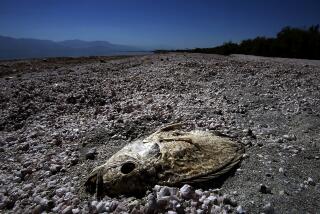Sniffing out the oil
Reporting from Pascagoula, Miss. — Robert Downs leads the scientists who sniff at fish.
Each day, his team of seven sensory experts dip their noses into large Pyrex bowls of snapper, tuna and other raw seafood to test for even a whiff of the pungent oil gushing into the Gulf of Mexico.
This is not Grand Cru wine.
“We use specific terms for the aroma,” said Downs, who supervises the seafood smellers at the National Oceanic and Atmospheric Administration’s marine lab here. “Diesel oil. Bunker oil. Asphalt. Rubber-band-like. Tar.”
Each olfactory analyst has a super schnoz, able to smell oil diluted to one part per million. That’s 40 times more sensitive than your average proboscis.
It’s also more sensitive than science can explain. Last month, the team caught a faint scent in a red snapper that chemists and toxicologists could not confirm despite three days of testing at an NOAA marine science lab in Seattle. The result: A rich fishing area off Louisiana’s coast stayed off-limits.
“The nose knows,” Downs said.
Strong stomachs help. The group has sniffed or tasted more than 1,000 fish in the nearly three months since the BP oil spill, and no one has gotten sick.
The fish smellers are part of a major effort by NOAA, the Food and Drug Administration, the Environmental Protection Agency and state governments to ensure that the still-leaking oil doesn’t pollute the nation’s food supply. So far, there are no confirmed reports of contaminated Gulf Coast seafood reaching consumers.
Partially because of the sniffers, NOAA has banned fishing in more than a third of the Gulf of Mexico, 81,181 square miles in all. State officials also have barred fishing along more than 550 miles of beaches and bayous from Louisiana to northern Florida.
“We have found tainted fish,” said John Stein, who runs the BP oil spill seafood safety testing program for NOAA. “It’s not uncommon.”
Stein spoke beside a huge chart of the Gulf of Mexico marked with scores of Xs. These looked suspiciously like the Xs that mark dead fish eyes in cartoons, but Stein insisted his Xs show where NOAA has caught live fish for baseline studies and surveillance testing.
Under federal law, fishing is banned if oil is seen in the water. So most samples that are tested are caught outside the vast no-go zone or in other waters that are not visibly oiled. Pelagic fish, which migrate, pose a special concern for fear they may ingest oil and swim away.
One of NOAA’s ships, the Delaware II, docked behind the long-established fisheries lab here recently after a weeklong cruise. Crew members gingerly carried off 11 large frozen fish — swordfish, blackfin tuna, mahi-mahi and others — wrapped in black plastic and duct tape, and placed them on a gurney.
Cheryl Lassitter, lead chemist at the lab, signed a clipboard to ensure a legal chain of custody for each fish. Tags tied to the bags showed where, when and how each fish was caught.
“They’re like dead bodies,” Lassitter said with a groan as she helped push the heavy gurney up a small hill.
An elevator took them to the lab’s second floor, where more scientists — and more fish — were waiting. A research biologist carefully sliced thick pink filets from a thawed 3-foot-long cobia, a pelagic fish sometimes called a ling or black salmon.
“I love sushi, but I’m not allowed to eat our samples,” said Lisa Desfosse, director of the 130-member marine lab, as she watched the dissection.
The filets were wrapped in foil and carefully labeled. Half would be refrozen and flown to NOAA’s Northwest Fisheries Science Center in Seattle. Scientists there will test the fish for polycyclic aromatic hydrocarbons, compounds in petroleum that are toxic and carcinogenic.
The other half went down the hall to Steven Wilson, a burly man with a trim white beard and a black lab coat, giving him the appearance of a barber. He is the chief quality officer for NOAA’s Seafood Inspection Program.
On one side of the lab, a tray held 10 perfume-like vials that the sniffers use to “harmonize and recalibrate” their senses each day, Wilson said. Each vial has a distinct bouquet — creosote, Alaska sweet, Louisiana crude, used oil, ammonia and so on.
Each day, the sniffers often sniff or taste two to three dozen bowls of seafood, some raw and some cooked. “After that, the nose gets tired,” Wilson said.
The team uses seven sniffers, with an eighth as an alternate, Wilson said, “in case someone gets a sinus infection. Or eats bad beef.”
To help cleanse the palate, or for a quick snack, bowls hold cut watermelon, sliced cucumbers, cooked corn and rice. The group works behind cardboard screens, like voting booths, to hide their reactions. They mark pass or fail, and any comments, on a score sheet.
Wilson offered to demonstrate. He lifted the lid of a Pyrex bowl of red snapper, leaned way down, and used his hand to fan fumes into his face. He took several shallow sniffs.
“I like to let the aromatics get in my head space,” he said. He stood and considered the odor. “It smells like really good snapper,” he finally declared.
He sniffed at his bare arm to give his nose a neutral scent. Then he stuck his face into a bowl of shucked oysters and sniffed again.
“Whoa!” he said. He staggered backward and blinked. “That smells off. I don’t smell oil. I just don’t like it.”
Neither the sniffers here nor the chemists in Seattle test for the 1.76 million gallons of chemical dispersants that BP has used at sea to help break up the oil. Critics say no one has adequately tested the dispersants for long-term effects on marine life, consumers or the environment.
At this point, the FDA has ruled that the chemicals have a “low potential” to bioaccumulate in marine life, are “low in human toxicity” and pose “little public health risk.” Like fish with faint traces of oil, any seafood that carries a chemical smell is considered adulterated and is illegal to sell.
NOAA has trained thousands of fish sniffers over the years to help guarantee food safety. Working with industry, they inspect seafood on ships and docks, in processing plants and markets for decomposition, contamination or other hazards to consumers. Other industries use sensory experts to ensure quality in coffee, beer and other foodstuffs.
But NOAA ramped up an emergency program after the BP spill, sending a team of trained sniffers to a laboratory in Gloucester, Mass., for a crash course with crude oil. Two dozen people have taken the class.
They will play a crucial role once BP finally caps the renegade well. Sniffers will help decide when fishing is again safe in the Gulf of Mexico, and when tens of thousands of commercial fishermen, charter boat captains, shrimpers, oystermen and others can return to their livelihoods.
Downs, the team leader, is up to the task. He has spent two decades training sensory experts. And yes, he eats fish regularly — mahi-mahi and grouper are his favorites. He says his sense of smell gives him a nose-up on most people.
“Last night, I went to a restaurant and took a whiff,” he said. “I knew right away the lobster was bad.”
More to Read
Sign up for Essential California
The most important California stories and recommendations in your inbox every morning.
You may occasionally receive promotional content from the Los Angeles Times.











